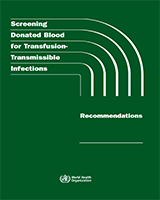All rights reserved. Publications of the World Health Organization can be obtained from WHO Press, World Health Organization, 20 Avenue Appia, 1211 Geneva 27, Switzerland (tel.: +41 22 791 3264; fax: +41 22 791 4857; e-mail: tni.ohw@sredrokoob). Requests for permission to reproduce or translate WHO publications – whether for sale or for noncommercial distribution – should be addressed to WHO Press, at the above address (fax: +41 22 791 4806; e-mail: tni.ohw@snoissimrep).
NCBI Bookshelf. A service of the National Library of Medicine, National Institutes of Health.
Overview
The establishment of systems to ensure that all donated blood is screened for transfusion-transmissible infections is a core component of every national blood programme. Globally, however, there are significant variations in the extent to which donated blood is screened, the screening strategies adopted and the overall quality and effectiveness of the blood screening process. As a result, in many countries the recipients of blood and blood products remain at unacceptable risk of acquiring life-threatening infections that could easily be prevented.
These recommendations are designed to support countries in establishing effective national programmes to ensure 100% quality-assured screening of donated blood for transfusion-transmissible infections. In countries where systems are not yet fully in place, the recommendations will be helpful in instituting a step-wise process to implement them.
Contents
- Preface
- Key recommendations
- 1. Introduction
- 2. National blood screening programme for transfusion-transmissible infections
- 2.1 DEVELOPING A NATIONAL BLOOD SCREENING PROGRAMME
- 2.2 NATIONAL POLICY ON BLOOD SCREENING
- 2.3 NATIONAL SCREENING STRATEGY
- 2.4 ORGANIZATION AND MANAGEMENT
- 2.5 FINANCIAL AND HUMAN RESOURCES
- 2.6 EVALUATION, SELECTION AND VALIDATION OF ASSAY SYSTEMS
- 2.7 LABORATORY QUALITY SYSTEMS
- 2.8 PROCUREMENT AND SUPPLY OF ASSAYS AND REAGENTS
- 2.9 STORAGE AND TRANSPORTATION
- 2.10 REGULATORY MECHANISMS
- 3. Screening assays
- 4. Screening for transfusion-transmissible infections
- 4.1 TRANSFUSION-TRANSMISSIBLE INFECTIONS
- 4.2 TRANSFUSION-TRANSMISSIBLE INFECTIOUS AGENTS FOR WHICH UNIVERSAL SCREENING OF ALL DONATION IN ALL COUNTRIES IS RECOMMENDED
- 4.3 TRANSFUSION-TRANSMISSIBLE INFECTIONS FOR WHICH UNIVERSAL SCREENING IS RECOMMENDED IN SOME COUNTRIES OR FOR WHICH SELECTIVE SCREENING IS RECOMMENDED
- 4.4 EMERGING AND RE-EMERGING INFECTIONS
- 4.5 CLINICALLY INSIGNIFICANT TRANSFUSION-TRANSMISSIBLE INFECTIONS
- 5. Blood screening, quarantine and release
- 5.1 BLOOD SCREENING PROCESS
- 5.2 APPROACHES TO BLOOD SCREENING
- 5.3 POOLING FOR SEROLOGICAL ASSAYS
- 5.4 SEQUENTIAL SCREENING
- 5.5 BLOOD SCREENING AND DIAGNOSTIC TESTING
- 5.6 EMERGENCY SCREENING
- 5.7 SCREENING PLASMA FOR FRACTIONATION
- 5.8 PRE-DONATION TESTING
- 5.9 QUARANTINE OF BLOOD AND BLOOD COMPONENTS PRIOR TO RELEASE OR DISCARD
- 5.10 RELEASE OF BLOOD AND BLOOD COMPONENTS
- 5.11 LONG-TERM STORAGE OF DONATION SERUM/PLASMA SAMPLES
- 6. Confirmatory testing and blood donor management
- 7. Quality systems in blood screening
- References
- Glossary
- Acknowledgments
Development of this publication was supported by Cooperative Agreement No. U62/PS024044-05 from the Department of Health and Human Services/Centers for Disease Control and Prevention (CDC), National Center for HIV, Viral Hepatitis, STD, and TB Prevention (NCHHSTP), Global AIDS Program (GAP), United States of America. Its contents are solely the responsibility of the authors and do not necessarily represent the official views of CDC.
The designations employed and the presentation of the material in this publication do not imply the expression of any opinion whatsoever on the part of the World Health Organization concerning the legal status of any country, territory, city or area or of its authorities, or concerning the delimitation of its frontiers or boundaries. Dotted lines on maps represent approximate border lines for which there may not yet be full agreement.
The mention of specific companies or of certain manufacturers' products does not imply that they are endorsed or recommended by the World Health Organization in preference to others of a similar nature that are not mentioned. Errors and omissions excepted, the names of proprietary products are distinguished by initial capital letters.
All reasonable precautions have been taken by the World Health Organization to verify the information contained in this publication. However, the published material is being distributed without warranty of any kind, either expressed or implied. The responsibility for the interpretation and use of the material lies with the reader. In no event shall the World Health Organization be liable for damages arising from its use.
- NLM CatalogRelated NLM Catalog Entries
- Seroprevalence and diagnosis of HIV, HBV, HCV and syphilis infections among blood donors.[Hum Antibodies. 2017]Seroprevalence and diagnosis of HIV, HBV, HCV and syphilis infections among blood donors.Tafesse TB, Gebru AA, Gobalee S, Belay GD, Belew MT, Ataro D, Ebrahim BA, Shebeshi GM, Yimam Y. Hum Antibodies. 2017; 25(1-2):39-55.
- Review Leukocyte reduction's role in the attenuation of infection risks among transfusion recipients.[Clin Infect Dis. 2007]Review Leukocyte reduction's role in the attenuation of infection risks among transfusion recipients.Cervia JS, Wenz B, Ortolano GA. Clin Infect Dis. 2007 Oct 15; 45(8):1008-13. Epub 2007 Sep 6.
- Review The use of rapid diagnostic tests for transfusion infectious screening in Africa: a literature review.[Transfus Med Rev. 2015]Review The use of rapid diagnostic tests for transfusion infectious screening in Africa: a literature review.Pruett CR, Vermeulen M, Zacharias P, Ingram C, Tayou Tagny C, Bloch EM. Transfus Med Rev. 2015 Jan; 29(1):35-44. Epub 2014 Sep 28.
- Analysis of quality assurance programmes for HIV screening in blood transfusion centres in Delhi.[Bull World Health Organ. 1997]Analysis of quality assurance programmes for HIV screening in blood transfusion centres in Delhi.Dhingra-Kumar N, Sharma AK, Madan N. Bull World Health Organ. 1997; 75(3):223-8.
- Blood safety & prevalence of transfussion transmissible viral infections among donors at the Red Cross Blood Bank in Gondar University Hospital.[Ethiop Med J. 2008]Blood safety & prevalence of transfussion transmissible viral infections among donors at the Red Cross Blood Bank in Gondar University Hospital.Diro E, Alemu S, G/Yohannes A. Ethiop Med J. 2008 Jan; 46(1):7-13.
- Screening Donated Blood for Transfusion-Transmissible Infections: Recommendation...Screening Donated Blood for Transfusion-Transmissible Infections: Recommendations
Your browsing activity is empty.
Activity recording is turned off.
See more...
